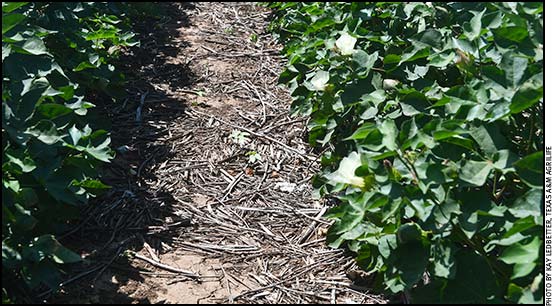MANAGEMENT...

More Mature Cover Crops Help Maintain Residue Longer
Water use will be replaced on irrigated cotton.
Often producers planting cover crops are worried about moisture use, but more important is the longevity of the crop residue and its beneficial results, said a Texas A&M AgriLife Research scientist.
Paul DeLaune, an AgriLife Research environmental soil scientist at Vernon, said when he talks about the residue management of cover crops, one question he is always asked concerns termination timing and the use of soil moisture by the cover crop.
Cover crops are designed to keep soil from blowing and improve soil quality. DeLaune has included Austrian winter field pea, hairy vetch, crimson clover, wheat, rye, turnips and radishes as cover crops in various studies. Read more.
Throw Your Calves a Weaning-time Potluck
Tips to get calves eating quickly and over the stressors of weaning.
You know the feeling of being at a big party or potluck? Everywhere you turn there’s food, food and guess what? More food. You think, “This must be heaven!” The same should be true for your weaned calves. They should encounter feed and water at every turn during weaning so they find feed sources and start eating and drinking quickly.
“When cattle are stressed, they often quit eating,” says Lee Dickerson, senior cattle consultant with Purina Animal Nutrition. “The sooner you can get your calves to eat, the less likely they are to get sick. A few adjustments to your weaning-time nutrition program can make a huge difference.” Read more.
Should I Cull or Keep that Cow?
There are many options to consider when creating a cull list, but it is important to stick to that decision.
When making culling decisions, it is important to have a plan to make the best decisions for your operation. The plan should include pregnancy testing and closely evaluating every cow, and having a plan for marketing the culls.
Bruce Viney, risk management specialist for Alberta Agriculture and Forestry says there are no right answers that fit everyone, and the best decisions vary from year to year because cattle prices are unpredictable. Read more.

Justin Sexten
Beef lessons from dairy conceptions.
You’ve heard that the key to beef quality could lie in making sure a calf never has a bad day. A paper in the Journal of Dairy Science adds validity — and before you quit reading because the work didn’t come from the beef side, think for a minute about the dairy cow. She’s a model of uniform genetics and focused selection with little nutritional limit to gene expression. She can serve as a great model to evaluate environment for all cows, independent of genetics and nutritional resources.
Contrast that to the beef cow with variable genetics selected for multiple traits and often limited by her nutritional environment. These diverse conditions are why the debate rages on about ideal cow size and milk production level. Read more.

Kris Ringwall
Beef Talk
Having cattle that are too large or too small has real consequences.
The search for efficient cows at the Dickinson Research Extension Center has resulted in “cow math,” the translation of biological and economic efficiency into the herd production inventory based on land units.
That is a lot to understand, but doable. The beef industry has efficient cows, but the definition of efficiency varies, depending on the background of the discussion.
At the center the search started in the mid-1990s. Some cows in the herd were approaching 1,800 to 2,000 pounds because growth was prevalent in the background genetics of the cattle and purchased sires were good growth bulls. Heifer replacement was a side product of these good growth bulls. Read more.
Carcass Quality Starts In Utero
Fetal programming plays a role in carcass quality.
Kim Vonnahme, professor at North Dakota State University, defined fetal programming as the in vitro environment that leads to a successful animal pregnancy. Speaking Aug. 30 at the Applied Reproductive Strategies in Beef Cattle (ARSBC) symposium in Manhattan, Kan., she outlined what it takes to reach the animal’s full genetic potential for carcass quality from the fetal phase.
“A classic animal breeding example is phenotype plus genotype plus environment,” Vonnahme said. “An animal can’t reach [its] genetic potential for carcass quality if the uterine environment is suboptimal.” Read more.
Angus Advisor
Click here for October herd management tips from cattle experts across the nation. Advice separated by region.
[Click here to go to the top of the page.]







